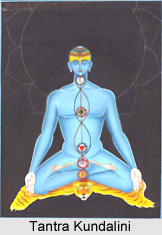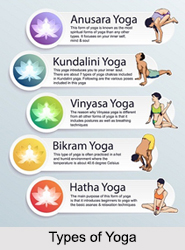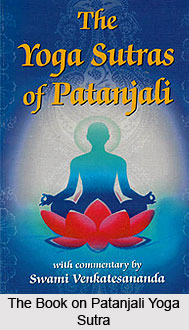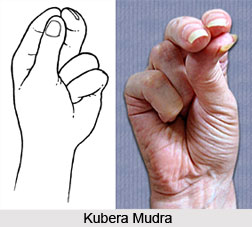 Yamas, Niyamas, Asanas and Pranayama as a group are considered as BAHIRANGA YOGA. It is as a way to achieve an objective perception or vision or a power of discriminating purusha from prakriti. As the first four parts (Angas) of Astanga Yoga viz. Yamas, Niyamas, Asanas and Pranayamas need not be observed necessarily in the same sequence. They are called essentially, the limbs of Astanga Yoga and not steps as such. It should be borne in mind that Patanjali lays an emphasis on the observance of Yamas and Niyamas while Hathayogic texts do not give the same importance to Yamas and Niyamas.
Yamas, Niyamas, Asanas and Pranayama as a group are considered as BAHIRANGA YOGA. It is as a way to achieve an objective perception or vision or a power of discriminating purusha from prakriti. As the first four parts (Angas) of Astanga Yoga viz. Yamas, Niyamas, Asanas and Pranayamas need not be observed necessarily in the same sequence. They are called essentially, the limbs of Astanga Yoga and not steps as such. It should be borne in mind that Patanjali lays an emphasis on the observance of Yamas and Niyamas while Hathayogic texts do not give the same importance to Yamas and Niyamas.
Yamas and Niyamas are known as `attitude forming yoga practices.` They provide a moral foundation for the yogic training. These are essential pre-requisite for the Sadhaka who aspires for `Higher Yoga.` However, for `Lower Yoga`, when Sadhaka wants to attain some evil powers (vama marga) the observance of Yamas and Niyamas are not essential. Yamas and Niyamas lay foundation for the Yogic life. The main object of these ethical codes of social conduct (Yamas) and personal conduct (Niyamas) is to eliminate completely all-mental and emotional disturbances, which characterize the life of a common man. Yamas and Niyamas help us to overcome our inborn reactivities, thus making us fit for higher yoga sadhana.
I. Yamas: These are the codes of self-restraint and they are five yamas and also called Mahavrtas:
•Ahimsa (Non-Violence).
•Satya (Truthfulness).
•Asteya (Non-stealing).
•Brahmacharya (mode of life or discipline conducive for spiritual attainment).
•Aparigraha (not accumulating of things).
These Yamas gradually develop and nurture healthy social values in sadhaka. These Yamas are called as Mahavratas (great vows) and are not conditioned by birth (social status, caste), region (place of living) or times (occasion). Usually the observance of a social practice undergoes a change according to the circumstances prevailing at particular time. For example in a society where the population of female out number that of males, there polygamy is allowed by law. But, Yamas are not conditioned by any of the conditions above. They can be practised under all situations.
a) Ahimsa (Non-Violence): Ahimsa should be practised on both behavioral and mental levels: not only actually causing injury to others should be avoided but also even thinking of violence should be avoided. The Ahimsa should be observed in all the three levels viz. Kayika (body), Vacika (speech) and Manasika (mind).
b) Satya (Truthfulness): Not only truthfulness is indicated by this term, but also it presupposes an honest and sincere act on the part of the sadhaka. An act of deceit or even an idea of deceiving is a breach of the Yama of satya. It should also be observed on all the three levels as mentioned above. It means strict avoidance of all exaggerations, equivocation and pretence of any kind. Any effort to keep falsehoods and false appearances causes emotional disturbances. A sadhaka aspiring to realize "Ultimate Truth" must start with observing "Truthfulness" in his own life.
c) Asteya (Non Stealing): It is not limited to depriving others of their belongings, but it also means not keeping an intention or desire to possess things belonging to others. Thus it is "Mental Asteya." Instances of stealing copyright materials and the plagiarism, often practised by writers and speakers, are examples not in keeping with Asteya. Other examples are taking and giving bribes and also enjoying many undue privileges. This should also be practised on all the three levels i.e. by body, speech and mind.
d) Brahmacharya: Usually translated as continence or abstinence from sex, celibacy, chastity etc. Thus, the broad meaning of brahmacharya is a mode of behaviour, which will be conducive for reaching the highest goal for the spiritual sadhaka. Brahmacharya actually includes all Yamas and Niyamas. If at all, only single `all inclusive` Yama was to be mentioned it could be "brahmacharya." It is obvious that in such a disciplined life the proper restraint of sex activity is very important. Therefore, fundamentally sex is not a thing to be deprecated and to be prescribed. Here, forceful restraint on sexual urges is not indicated. In sum, a judicious control on sex is recommended according to the needs of the sadhaka. It is said that Yamas and Niyamas prepare a sadhaka for asanas and Pranayamas. But even the practice of asanas and Pranayama will help sadhaka in observing Yamas and Niyamas. In fact, all the six other parts of Astanga Yoga help sadhaka to observe Yamas and Niyamas.
e) Aparigraha (Non Possessiveness):Not only mental attachments to things are to be given up, but also actual restraints from amassing or collecting the things are indicated here. Aparigraha on mental level is samnyasa and the practical aspect of samnyasa in actual life is Aparigraha. Aparigraha without samnyasa is not practical because the person may again aspire and try to acquire worldly things. Hence Aparigraha and samnyasa should go hand in hand.
II. NIYAMAS
Generally called (by some authorities on Yoga) as codes of personal conduct. While practices included in Yamas are moral and prohibitive those in Niyamas are disciplinal and constructive. Unlike Yamas, Niyamas are to be practised by sadhaka even if he is alone.
a) Sauca (Cleanliness): By most commentators of Patanjala Yoga Sutras Sauca means purification of mind and body. And given below are the ways, as to how one can purify the same.
Purity of Body:
•By usual way of cleaning one`s body parts and keeping them in healthy conditions.
•By consuming nutritious and vegetarian diet making the internal environment pure.
•By cleansing internal organs by neti, basti, dhauti etc
•Also by cleansing the body by Ayurvedic techniques of Pancha Ka
Purity of Mind:
•By allowing healthy thoughts and emotions and also by cleansing one`s mind of unwanted thoughts, feelings and emotions through `catharsis`.
•By mantras and prayers one can cleanse one`s thought process.
b) Samtosa (Contentment): Sadhaka aims at attaining a condition in which he remains perfectly calm and serene, irrespective of whatever may happen in the outer world. This kind of equanimity can be gained on the foundation of perfect contentment. This is a positive mental attitude and is based on a perfect indifference to the personal enjoyments, comforts etc. For attaining samtosa, a constant alertness and a training of the mind, in maintaining the right attitude, is necessary.
c) Tapas (Purification +Self Discipline + Austerity):
In a usual sense, tapas is known to include such practices as fasting, observing vows of various kinds, pranayama etc. The main aim of tapas is to purity our mental make up by making it undergo strict discipline and some well-planned austere techniques. Usually pranayama is taken as the foremost practice to represent tapas.
d) Swadhyaya (Self- Study): A thorough and detailed study of yogic literature is necessary part of swadhyaya. A constant brooding and reflection over the deeper problems, which have been studied from books, prepares the mind to aspire for the "Real Knowledge". This brooding and reflection gradually begins to take the form of meditation, a state of deep absorption. The sadhaka, at this stage may use mantras and prayers for greater effects.
e) Iswara Pranidhana (Total Surrender to God): The attitude of surrender is born not out of the feeling of helplessness, but it is born out of the pious feeling that God is the supreme authority and a total surrender to Him is a form of prayer. Iswara Pranidhana easily removes the I-consciousness of man. The I--consciousness is the product of unreal knowledge when we identify ourselves with our body, mind, thoughts etc. While surrendering our `being` we surrender our ego and thus become ego-less and this condition is a foremost condition to progress on the path of Yoga. Gradually sadhaka may feel desire-less and equality with all creations of God. Thus he may go towards "Self Realization". In some institutions a practical course of Kriya Yoga comprising well laid out programme of tapas. swadhyaya and Iswara pranidhana is followed, where by usually tapas is represented by pranayama. Swadhyaya is represented by pranava japa and Iswara pranidhana by Gayatri mantra.
III. Asanas
Made up from the root, the term asana means - by which we sit. Hence, asanas are particular postures or poses of sitting. Asana also means, "any posture of body which will be comfortable and which could be maintained steadily for adequately long time." This definition makes it clear that asana gives comfort and stability on both physical and mental levels. It has been found from various researches that the practice of asanas causes a shift towards parasympathetic function of autonomic nervous system. It results in inward awareness, introspection, tranquility and an inner satisfaction. Asanas are known to tone up autonomic nervous system, respiratory system, endocrine glands, spinal cord and visceral organs. This results in an overall physical and emotional stability. Certain asanas, named as relaxative and meditative, are especially suitable for mental and spiritual aspects of human personality.
IV. Pranayamas
Pranayamas are yogic breathing patterns. They are known to be closely related to the emotional aspect of one`s personality. Together with asanas, pranayamas are believed to be very effective in bringing about a psycho physiological balance. Pranayamas have been found to influence our moods and emotions favorably and hence, are supposed to have a therapeutical value for the psychoneurotic patient.
Prayer
The word prayer is originally derived from "praier prior precari prex" meaning to request (quest = longing). The Sanskrit word for prayer is Prathana and it has the same meaning i.e. an intensive longing. Thus, the concept of prayer cuts across the boundaries of languages, countries, religions etc. The most authoritative definition of prayer has come from Teresa of Avila, the 16th Century Spanish mystiec, which says, "Prayer is an initimate friendship, a frequent conversation held alone with the beloved i.e. God.
Methods used in Prayers:
Benefits of Prayer:a) Petition: This method literally means, appealing or requesting God. This method is the one mostly used in all the religions and most of gods devotees, use this method.
b) Confession: Affirmation of faith accepting one`s shortcomings and undesirable acts in front of God. This form of prayer is prevalent in major religions e.g. Judaism, Christianity Hinduism and Buddhism. Buddhists monks confess their, undesirable doings in front of public congregation two times every month.
c) Intercession: This is an impersonal prayer for others, just the way Moses, Jesus and even Mahatma Gandhi said their prayer to god, requesting pardon for others.
d) Praise and Thanks Giving: Pigmies of Africa: Mealtime prayer in many cultures are linked with an offering. In almost all religions this form of prayer is seen. Pranava japa (Om Recitation) and stotras are nothing but the praise of the almighty.
e) Ecstasy: In some religious sects the devotees sing and dance until they experience a "Divine Ecstasy".
f) Adoration: In Islam simply adoration is emphasized. In Sufi sect adoration of and conversation with Allah (God) is prevalent.
Thus, looking at the different methods, the types of prayer can be segregated in the following ways:
Personal: For personal gains and personal security.
Impersonal: Pure form of prayer for common good with self-less ness.
Collective: Group prayer held at temples, or at places of pilgrim importance, like a mass in a church, a Namaz in a mosque.
a) In prayer, unknowingly we entertain serene and virtuous thoughts only. Constant thinking of noble thoughts may transform our thought patterns in positive directions. Thus, prayers purifies ones heart and soul.
b) In initial stages of prayer, repressed thoughts, feelings, wishes and emotions may come to the surface of the mind. These may find their way out gradually, cleansing our mind in the process. Thus, prayer opens the gate of Mental Health.
c) In prayer, within us, we invoke, vastness of thoughts and think of noble deeds.
d) Prayer brings power of concentration easiest and natural way.
e) Prayer brings about thoughts and emotions in a most natural way. As a result Manomaya Kosha is managed properly. This leads to proper functioning of body activities, because of which movement of prana within the body starts functioning in a normal way.
f) Bhakti Yoga is considered most easy and effective way of all other ways (of yoga Sadhana). Truly, prayer is most natural and spontaneous way available to the common man to achieve Mental Health. Thus, integration of personality and self-realization can be achieved in due course of time, through prayer.




















